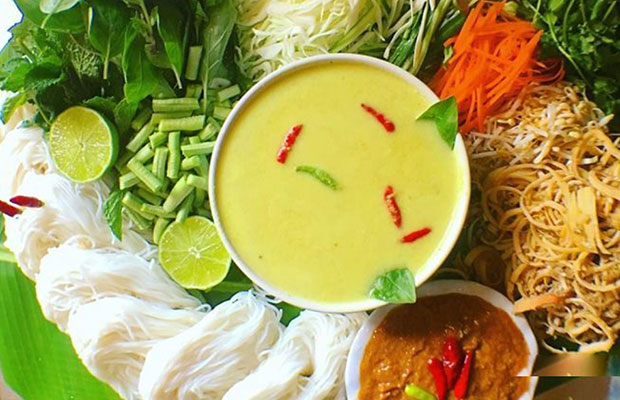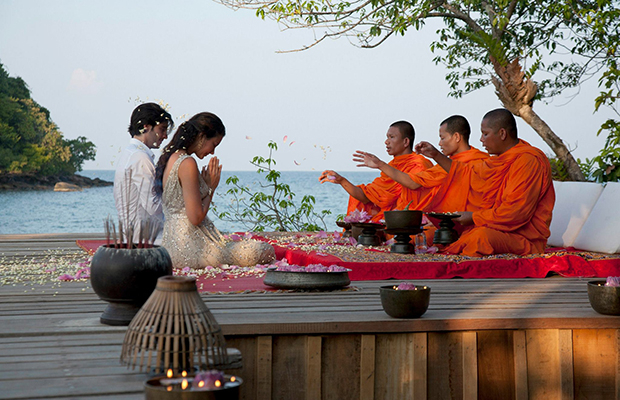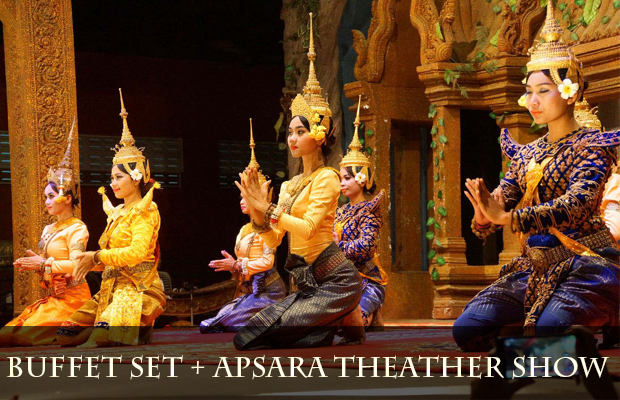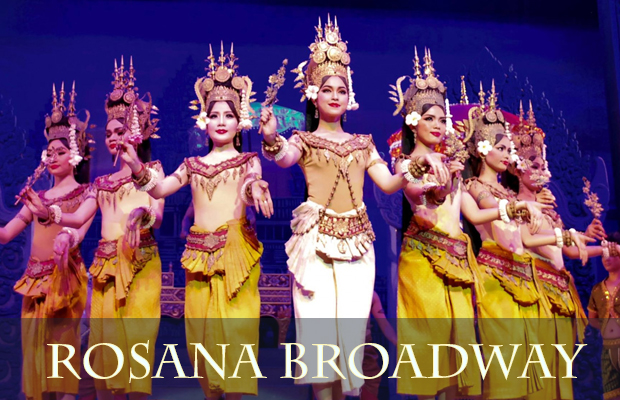Cambodia Information
Cambodian Food & Drink
Traditional Khmer Food, or more generally, Cambodian cuisine is one of the worlds oldest living cuisines, and is regarded by many as one of the healthiest and most balanced cuisines on the planet. With an emphasis on simplicity, freshness, seasonality and regionalism – Cambodian food has won praise for its elegant and understated use of spice, its harmonious arrangement of contrasting flavours, textures and temperatures within the overall meal rather than a single dish, and its thoughtful and, at times extravagant presentation of dishes with plenty of herbs, leaves, pickles, dipping sauces, edible flowers and other garnishes and condiments.
The staple food for Cambodians is rice, and today rice is consumed by most Cambodians daily and with all meals, utilising a great number of cooking styles and techniques. In fact, Cambodians eat more rice than any other people in the world: the Khmer expression for "Have you eaten?" (nyam bay?) is "Have you yet eaten rice?". There are over a hundred words and phrases for rice in the Khmer language as well as hundreds of varieties of indigenous Khmer rice, from the fragrant jasmine-scented Malis rice, to countless types of wild, brown and sticky rice. Sticky rice is most often consumed as a dessert, often simply with slices of tropical fruit like mango or durian, and coconut milk.
In addition, rice is eaten all day long in the form of street-side snacks, such as deep-fried rice cakes with chives and spinach, for breakfast, as in Cambodia's famous rice noodle soup kuyteav or rice porridge, and in many desserts. Plain white rice is served with nearly every family meal, typically served with grilled freshwater fish, a samlor or soup, and an assortment of seasonal herbs, salad leaves and vegetables.
Khmer cuisine, like its people, has shown remarkable resilience in the face of adversity and challenges. It must be reminded that during the horrors of the Khmer Rouge regime of the 1970s, Cambodian cuisine was almost wiped out and forgotten, and it's only been quite recently that Khmer cuisine has made something of a revival. Living standards have dramatically improved over the last fifteen years, and today several cooking courses are now run in Phnom Penh, Siem Reap and Sihanoukville, and other popular tourist areas, giving visitors the chance to share the culinary secret of the Khmers.
Khmer Food Ingredients
+ Prahok
A common ingredient, almost a national institution, is a pungent type of fermented fish paste used in many dishes, a distinctive flavoring known as prahok (??????). It's an acquired taste for most Westerners, but is an integral part of Khmer cuisine and is included in many dishes or used as a dipping sauce. The liberal use of prahok, which adds a salty tang to many dishes, is a characteristic which distinguishes Khmer cuisine from that of its neighbours. Prahok can be prepared many ways and eaten as a dish on its own right. Prahok jien (?????????), is fried and usually mixed with meat (usually beef or pork) and chilli. It can also be eaten with dips, vegetables like cucumbers or eggplants, and rice. Prahok gop or Prahok ang (?????????) or (??????????) is covered with banana leaves and left to cook under a fire under pieces of rock or over the coals.
When prahok is not used, kap? (????), a kind of fermented shrimp paste is used instead. Khmer cuisine also uses fish sauce widely in soups and stir-fried dishes, and as a dipping sauce.
+ Spices
Unknown in Asia before the 16th century, the chili pepper arrived with the Portuguese. More years still passed before the chili pepper reached Cambodia and, to this day it lacks a certain status in Khmer cooking and is not extensively used, unlike neighbouring Thailand, Laos or Malaysia. Black pepper is the preferred choice when heat is wanted in a dish; it is used in stir fries, soups, marinades for grilled meats, and dipping sauces. Pepper has a long history in Cambodia, having been grown since at least the 13th century, while the pungent, aromatic variety from Kampot province (bordering Vietnam Ha Tien province on the east, the Gulf of Thailand to the south, and the jungle-clad Elephant Mountains to the north) was once Cambodia's chief export from the late 1800s up till the 1960s.
Kampot pepper was once known as the King of Peppers, revered by gourmands worldwide for its floral and eucalyptus notes, its heady aroma, its musky heat, and its medicinal properties. Before the 1970s, Kampot pepper was used in all French restaurants for the classic dish steak au poivre. Today, the pepper industry is being revitalised and, since acquiring protected Geographic Indication status in 2008 (which gives it the same special status as Champagne in France), people can now purchase Kampot pepper online in many parts of the world, allowing a new generation of gourmands to rediscover one of the world's most elusive and prestigious spices.
Jungle cardamom, or wild cardamom, grows in the aptly named Cardamom Mountains in the southwest of the country, bordering the Gulf of Thailand coast to the south and Trat province in Thailand to the west. These vast mountains form the last remaining area of intact virgin rainforest in Southeast Asia and harbour extensive mangrove forests, elephants, tigers, Siamese crocodiles and other rare and endangered species, and few people live in this area. Locals use cardamom medicinally and in certain samlors, using the root of the plant as well as the pod. Saffron is grown around Battambang province and is used in many curry powders, soups and rice dishes, and again is used medicinally.
Tamarind is commonly employed as a soup base for dishes such as samlar machu. Star anise is a must when caramelizing meat in palm sugar like pork in the dish known as pak lov. Turmeric, galangal, ginger, lemongrass and kaffir lime leaves are essential spices in Khmer cooking, Khmer stews, and nearly all curries.[1]
+ Kroeung
From India, by way of Java, Cambodians have been taught the art of blending spices into a paste using many ingredients like cardamom, star anise, cloves, cinnamon, nutmeg, ginger and turmeric. Other native ingredients like lemongrass, galangal, garlic, shallots, cilantro, and kaffir lime leaves are added to this mix to make a distinctive and complex spice blend called "kroeung." Other ingredients for kroeung used by Khmers in America are lemongrass, turmeric powder, garlic, prahok, and lemon leaf. This is an important aromatic paste commonly used in Cambodian cooking.
+ Vegetables
Many vegetables used in Khmer cuisine are also used in Chinese cuisine. Vegetables such as winter melon, bitter melon, luffa, and yardlong beans can be found in soups and stews. Oriental squash can be stewed, stir fried or sweetened and steamed with coconut milk as a dessert. Vegetables like mushrooms, cabbage, baby corn, bamboo shoots, fresh ginger, kai-lan ("Chinese broccoli"), snow peas, and bok choy are commonly used in many different stir fry dishes. Together these are known by the generic term chhar (??). Banana blossoms are sliced and added to some noodle dishes like nom banh chok.
+ Fruits
Fruits in Cambodia are so popular that they have their own royal court. The durian is considered the "king," the mangosteen the "queen," sapodilla the "prince" and the milk fruit (phlai teuk doh ko) the "princess." Other popular fruits include: the jan fruit, kuy fruit, romduol, pineapple, star apple, rose apple, coconut, palmyra fruit, jackfruit, papaya, watermelon, banana, mango and rambutan. Although fruits are usually considered desserts, some fruits such as ripe mangoes, watermelon, and pineapples are eaten commonly with heavily salted fish with plain rice. Fruits are also made into beverages called tuk kolok (??? ????), mostly shakes. Popular fruits for shakes are durian, mangoes, bananas.
+ Fish and meat
As the country has an extensive network of waterways, freshwater fish plays a large part in the diet of most Cambodians, making its way into many recipes. Daily fresh catches come from the Mekong River, Bassac River and the vast Tonlé Sap. Fish is far more common than meat in Khmer cuisine and fish forms 60% of the Cambodian intake of proteins. Prahok itself is based on fish. Many of the fish types eaten in Cambodia are freshwater fish from the Tonlé Sap or from the mighty Mekong. Dried salted fish known as trei ngeat (???????) are a favourite with plain rice porridge. The popular Khmer dish called amok uses a kind of catfish steamed in a savoury coconut-based curry. The small fishes known as Trey Dang Dau are very common and are often eaten deep-fried.
While freshwater fish is the most commonly used meat in the Cambodian diet, pork and chicken are also popular. Though not as common as in neighboring Vietnam, vegetarian food is a part of Khmer cuisine and often favored by more observant Buddhists.
Pork is quite popular in making sweet Khmer sausages known as twah ko (???????). Beef and chicken are stewed, grilled or stir fried. Seafood includes an array of shellfish like clams, cockles, crayfish, shrimp and squid. Lobsters are not commonly eaten because of their price, but middle-class and rich Cambodians enjoy eating them at Sihanoukville. Duck roasted in Chinese char siu style is popular during festivals. More unusual varieties of meat include frog, turtle, and arthropods like tarantulas; these would are difficult to find in Khmer cuisine abroad but are used in everyday dishes in Cambodia.
+ Noodles
Many elements of Cambodian noodle dishes were inspired by Chinese and Vietnamese cooking[3] despite maintaining a distinct Khmer variation. Prahok is never used with noodle dishes. Rice stick noodles are used in mee katang (????????), which is a Cambodian variation of ch?o f?n with gravy. Unlike the Chinese styled ch?o f?n, the noodles are plated under the stir fry beef and vegetables and topped off with scrambled eggs. Burmese style noodles (?????? - Mee Kola) is a vegetarian dish made from thin rice stick noodles, steamed and cooked with soy sauce and garlic chives. This is served with pickled vegetables Jroak (?????), julienned eggs, and sweet garlic fish sauce garnished with crushed peanuts. Mi Cha (????) is stir fried egg noodles.






























